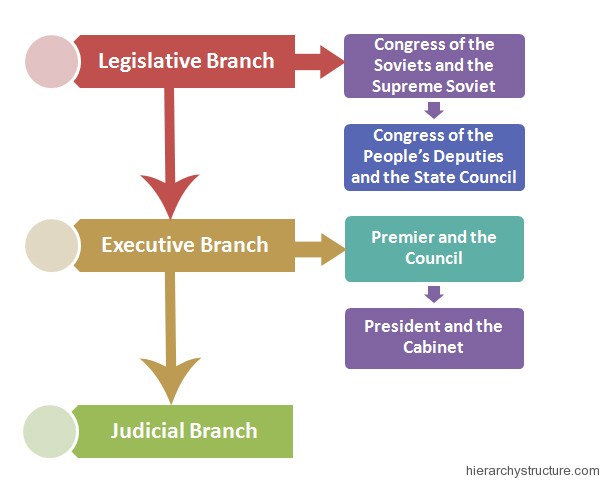The government and politics of the Soviet, also referred as the Union of the Soviet Socialist Republics is broadly characterized by the superior role of the Communist Party of the Soviet Union, abbreviated as the CPSU. The CPSU is the only political party permitted by the constitution of the Union of the Soviet Socialist Republics. The Soviet Union government exercised its amorous executive powers in compliance with legislation and the Soviet Constitution enacted by the Supreme Soviet of the Soviet Union. The Soviet royal hierarchy is briefly explained as below in a format of descending order means starting with the highest rank of the hierarchy and ending with the lowest one –

- Legislative Branch
Congress of the People’s Deputies and the State Council
Congress of the Soviets and the Supreme Soviet
- Executive Branch
President and the Cabinet
Premier and the Council
- Judicial Branch
Legislative Branch
The highest power and authority holder branch in the Soviet political hierarchy is the legislative branch which deals with framing of laws. It incorporates two more sub categories which are described below in brief:
- Congress of the Soviets and the Supreme Soviet – The Congress of Soviets was the ultimate supreme organ of the power in accordance to the Soviet constitution of the year 1924. The Congress was replaced in the Soviet Constitution of the year 1936 by the Supreme Soviet of the Soviet Union. This functioned as the highest state authority and the only legislative branch of the USSR.
- Congress of the People’s Deputies and the State Council – Out of the total seats, around 1/3rd seats are pre-reserved for public organizations and communist parties.
Executive Branch
The middle level of the Soviet political hierarchy is the executive branch and further incorporated two sub divisions that are described below in brief:
- Premier and the Council – The executive branch was headed by the Council of People’s Commissars according to the Soviet constitution of the year 1924. The head of the executive branch was appointed the Council of the Ministers. The Council of Ministers was both responsible for and accountable to the Supreme Soviet and further was responsible for management of the national economy and its socio-cultural construction and development.
- President and the Cabinet – In the year 1990, the head of the executive branch was appointed the President of the Soviet Union by the Mikhail Gorbachev. It lead to the dissolve of the council of ministers and in their place, the Cabinet of Ministers of the USSR was introduced. After this the newly formed Cabinet was ruled and governed by the Premier.
Judicial Branch
In the Soviet political hierarchy, the honorable Supreme Court is the highest judicial body in the country. The principal task of the judicial branch is to enforce the law. The main role of the Supreme Court is to supervise the administration of justice as per the policies established by the law.
